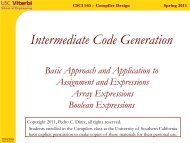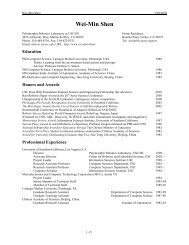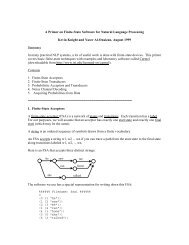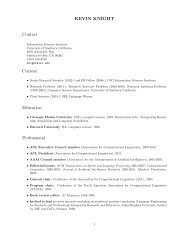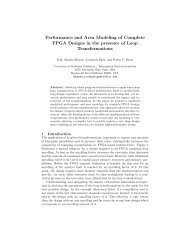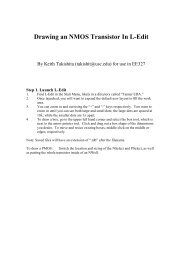Induction of Word and Phrase Alignments for Automatic Document ...
Induction of Word and Phrase Alignments for Automatic Document ...
Induction of Word and Phrase Alignments for Automatic Document ...
You also want an ePaper? Increase the reach of your titles
YUMPU automatically turns print PDFs into web optimized ePapers that Google loves.
Computational Linguistics Volume 1, Number 1<br />
sales” would have probability jump syn (VBD PRP POS NNS) while to jump over “<strong>of</strong><br />
Apple Macintosh systems” would have probability jump syn (PP). In order to compute<br />
the probabilities <strong>for</strong> jumps over many components, we factorize so that the first probability<br />
becomes jump syn (VBD)jump syn (PRP)jump syn (POS)jump syn (NNS). This factorization<br />
explicitly encodes our preference <strong>for</strong> jumping over single units, rather than several<br />
syntactically unrelated units.<br />
In order to work with this model, we must first parse the document side <strong>of</strong> the<br />
corpus; we used Charniak’s parser (Charniak, 1997). Given the document parse trees,<br />
the re-estimation <strong>of</strong> the components <strong>of</strong> this probability distribution is done by simply<br />
counting what sorts <strong>of</strong> phrases are being jumped over. Again, we keep a single parameter<br />
jump syn (∅) <strong>for</strong> jumping to null states. To h<strong>and</strong>le backward jumps, we simply<br />
consider a duplication <strong>of</strong> the tag set, where jump syn (NP-f) denotes a <strong>for</strong>ward jump over<br />
an NP <strong>and</strong> jump syn (NP-b) denotes a backward jump over an NP. 6<br />
4.2 Parameterizing the rewrite model<br />
As observed from the human-aligned summaries, a good rewrite model should be able<br />
to account <strong>for</strong> alignments between identical word <strong>and</strong> phrases, between words that<br />
are identical up to stem, <strong>and</strong> between different words. Intuition (as well as further<br />
investigations <strong>of</strong> the data) also suggest that synonymy is an important factor to take into<br />
consideration in a successful rewrite model. We account <strong>for</strong> each <strong>of</strong> these four factors in<br />
four separate components <strong>of</strong> the model <strong>and</strong> then take a linear interpolation <strong>of</strong> them to<br />
produce the final probability:<br />
rewrite(s | d) = λidrewriteid(s | d) + λstemrewritestem(s | d) (2)<br />
+ λwnrewritewn(s | d) + λrwrewriterw(s | d) (3)<br />
where the λs are constrained to sum to unity. The four rewrite distributions used<br />
are: id is a word identity model, which favors alignment <strong>of</strong> identical words; stem is a<br />
model designed to capture the notion that matches at the stem level are <strong>of</strong>ten sufficient<br />
<strong>for</strong> alignment (i.e., “walk” <strong>and</strong> “walked” are likely to be aligned); wn is a rewrite model<br />
based on similarity according to <strong>Word</strong>Net; <strong>and</strong> wr is the basic rewrite model, similar<br />
to a translation table in machine translation. These four models are described in detail<br />
below, followed by a description <strong>of</strong> how to compute their λs during EM.<br />
4.2.1 <strong>Word</strong> identity rewrite model. The <strong>for</strong>m <strong>of</strong> the word identity rewrite model is:<br />
rewriteid(s | d) = δs=d. That is, the probability is 1 exactly when s <strong>and</strong> d are identical,<br />
<strong>and</strong> 0 when they differ. This model has no parameters.<br />
4.2.2 Stem identity rewrite model. The <strong>for</strong>m <strong>of</strong> the stem identity rewrite model is very<br />
similar to that <strong>of</strong> the word identity model:<br />
rewritestem(s | d) = 1<br />
Zd<br />
|s|<br />
�<br />
δ |s|=|d| δstem(si)=stem(di) That is, the probability <strong>of</strong> a phrase s given d is uni<strong>for</strong>m over all phrases s ′ that<br />
match d up to stem (<strong>and</strong> are <strong>of</strong> the same length, i.e., |s ′ | = |d|), <strong>and</strong> zero otherwise. The<br />
6 In general, there are many ways to get from one position to another. For instance, to get from “systems”<br />
to “January”, we could either jump <strong>for</strong>ward over an RB <strong>and</strong> a JJ, or we could jump <strong>for</strong>ward over an ADVP<br />
<strong>and</strong> backward over an NN. In our version, we restrict that all jumps are in the same direction, <strong>and</strong> take the<br />
shortest jump sequence, in terms <strong>of</strong> number <strong>of</strong> nodes jumped over.<br />
14<br />
i=1<br />
(4)





